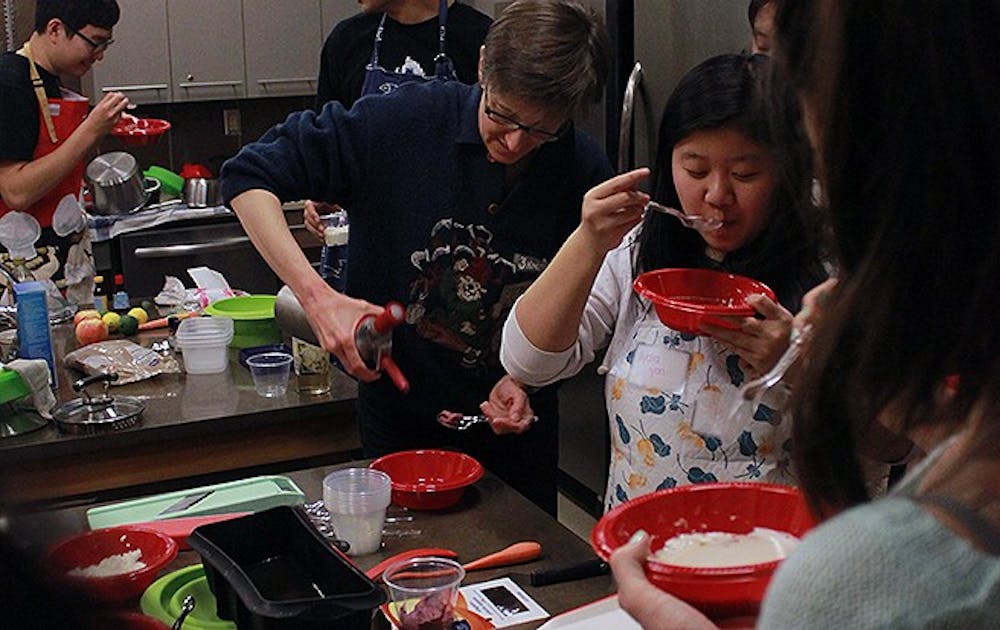A chemistry professor took the concept of applied science to make chocolate lava cakes, parmesan noodles and ice cream.
In the lab portion of Chemistry 89S: “Science of Cooking,” taught by Patrick Charbonneau, students handle cooking ingredients and thermal baths, rather than chemicals and test tubes, to learn basic science. Charbonneau, assistant professor of chemistry, physics and computational biology and bioinformatics, teamed up with chef Justine de Valicourt, visiting artist at Duke, to create the interdisciplinary course, a freshman seminar which uses cooking to explain fundamental chemistry concepts.
“The class is about breaking down barriers,” Charbonneau said. “A lot of chemistry classes like to say that they do, but we really do.”
In the introductory course, students learn basic scientific principles in lecture and then break into labs where they apply the new information by making gourmet food. On Tuesday, students gained a greater understanding of heat diffusion by making chocolate lava cakes. Prior to cooking, students did problem sets to figure out the temperature and length of time needed to make a cake with a hard outside and molten inside.
Creativity is encouraged, as students are allowed to add extra ingredients, such as chili pepper, to their cakes. Teaching fellows used liquid nitrogen to make ice cream outside of class as a complement to the lava cakes.
“I got really lucky being in the first registration window,” freshman Allen Shi said. “The concepts aren’t hard, and it’s interesting to see how science applies to food, which you don’t get to see in high school.”
Filling up within six seconds at the start of class registration, Chemistry 89S will not exist next year as a result of de Valicourt’s departure at the end of this semester. Because the course was so successful, however, there is a possibility that the course may exist later on if another chef were interested in taking the position.
Some students taking the course noted that, with science tending not to be their strongest subject, the course broke concepts down in a fun and interesting way.
Freshman Antoinette Hayford said the course allows for a good balance between free time and academics. Not only was she able to fulfill a natural science requirement, but the course allowed her to continue her hobby of cooking.
Teaching fellows who are assisting with the course added that, despite having an deep understanding of chemistry, the course allowed them to see the intersection between science and everyday life in a way they did not before.
“It’s changed the way I think about restaurants because the class offers an explanation to the cooking process,” Mary Jane Simpson, a fourth-year graduate student in chemistry, said. “When I go to a restaurant and see green in my eggs, I know that’s a sulfur compound that formed from overcooking, and I judge the restaurant.”
Keely Glass, also a fourth year graduate student in chemistry, added that she cooks more as a result of co-lecturing the course because seeing the intersection between science and food makes the process more enjoyable.
The class itself was created on the foundation of two friends. Charbonneau and de Valicourt, both originally from Quebec, Canada, have known each other since college, but their friendship goes back even farther. Both Charbonneau and de Valicourt's sister attended the same high school before going to Cégep Bois-de-Boulogne, an academic institution that offers a two or three year study program.
De Valicourt was was planning for a career in medicine as an undergraduate, but realized after graduating that she missed having art in her life.
“I thought cooking was the best art that also went into science,” she said. “It was easier to become a chef then, say, a painter.”
For the past three years, de Valicourt has worked in restaurants throughout Europe in countries such as France, Denmark and Spain.
Every year, departments are given the opportunity to have a visiting artist to help teach courses. Although the visiting artist typically does not work in a science department, Charbonneau decided to reach out to de Valicourt and see if the two of them could form a partnership to teach Duke’s very first chemistry and cooking class.
After a year of bouncing ideas back and forth, Charbonneau and de Valicourt were given the green light.
“I really like to be in a higher education environment,” de Valicourt said. “I love cooking and kitchens, but I get bored of talking about sports and cars all of the time. I missed having intellectual stimulation.”
De Valicourt’s connections as a chef made it easier to get equipment necessary for the course, all of which are donated, the most expensive being a vacuum sealer donated by Minipack America, which takes the air out of bags of foods. Still, the course is a learning process for the professors and students alike, as Charbonneau and de Valicourt have worked to improve the class week by week.
“We like to argue with each other,” de Valicourt said.
Correction: An earlier version said Charbonneau and de Vailcourt attended the same high school, when it was in fact Charbonneau and de Valicourt's sister. It also said they attended Cegep Garneau, when it was in fact Cegep Bois-de-Boulogne. The Chronicle regrets the error.
Get The Chronicle straight to your inbox
Signup for our weekly newsletter. Cancel at any time.

